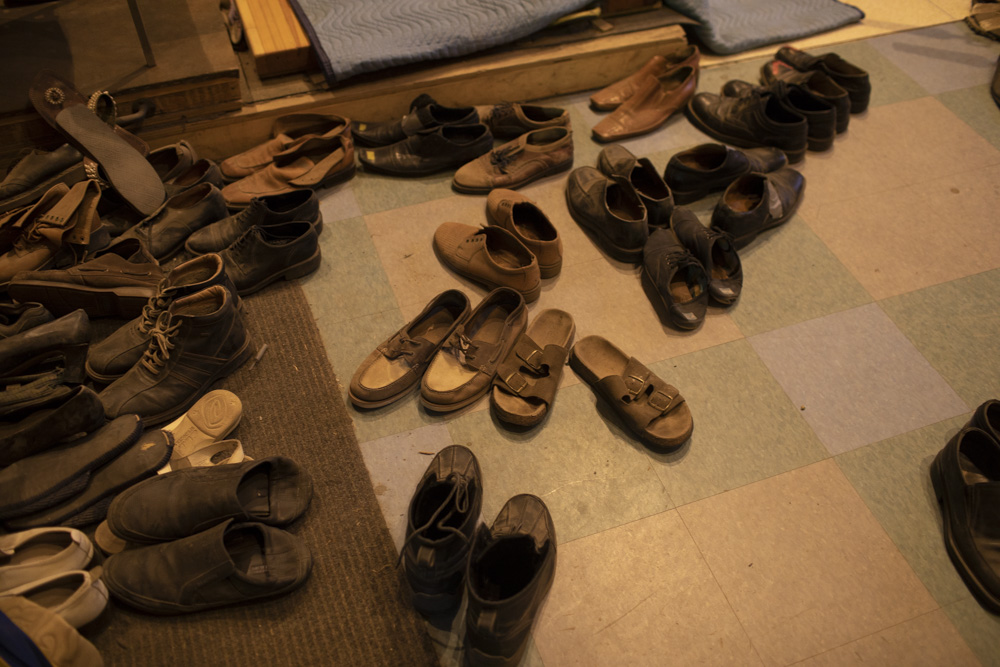“Sound is 50 percent of the movie-going experience…” – George Lucas
The Star Wars series is the perfect example to Mr. Lucas’ statement. From the sound design of the fictional spacecrafts to the lightsaber, the soundtrack of these films enhances the experience and draws audiences to the cinema. One of the most famous sounds in these films is the often-mimicked voice of Darth Vader. The distorted, heavy breathing not only adds to his sinister quality, but more importantly defines his character. Distinctive dialog, creative sound effects and an emotive score all have an important role in adding to and developing character(s). With foley, we also have the ability to specifically create a character’s sonic presence from scratch through their footsteps, clothing moves and interactions with props.
A Step in the Right Direction
Careful consideration is put into creating a specific sound for each character and one element that foley artists use to define that sound is in the choice of footwear. Tenured foley artists have spent years cultivating their shoe collection and they know exactly what each pair will sound like. Not only that, they also know how to manipulate those shoes to create varying amounts of weight (for an adult vs a child). In the editing and mixing stage, we also have the ability to manipulate the footsteps using pitch and EQ. Pitching down or boosting low end in footsteps can help enhance a character’s mass whereas the opposite can help define a lighter or smaller character.
Sometimes the character’s walk itself is a defining characteristic. For instance, in a period drama our team has worked on, there is a character who has no function of his legs. This is his defining characteristic so getting the sound of his movements requires very specific detail to make him sound convincing. When he isn’t dragging himself along the ground, he makes use of crutches. As the series has progressed, his crutches develop and become more sophisticated; so too does the sound we have created for him.
The surface on which the footsteps occur can make a huge difference in placing a character in a specific venue. For example, the sound of wet feet on a tile surface is easily recognizable and tells the viewer that the floor is wet. A small detail like this can help put the audience in that environment even if there are no visual cues to coincide. Similarly, adding grittiness to a surface is a small detail that can add depth and character to the footsteps.
From high heels to large clunky boots, footwear plays a large role in the definition of a character’s sonic presence. But there are other aspects of foley that help to define a character that should not be overlooked.

Clothing Is Key
An underrated aspect of the foley track is cloth movement. A clothing moves pass is used to help ‘glue’ all of the foley together – it acts as a sort of blanket connecting the other elements of a soundtrack. It is also often used to assist the mixer in blending in any ADR tracks, so it is a crucial element. But cloth can also help in defining a character as we often use and have access to many different types of clothing materials. A leather jacket for instance is a great way to make a character stand out, as the sound of the creaky leather is easily discernable. Certain materials can help place a character in a specific era of time as can also be heard in period dramas where characters often wear bulky fur pelts or thick canvas type material.
Another element of movement we often add to characters is a pass of gear moves. These tracks can also help define a character’s occupation and time period they reside in. With militant characters like police officers and soldiers, a pass of gear moves consisting of belts, buckles, keys and gun rattles can help solidify the audience’s belief in the character. Along with gear moves, in period media, we often perform armor moves for warriors or soldiers. The choice of armor material (wood, metal, etc) can help define a character’s economic status and the time period as well.

Proper Character
There are such a vast variety of props available to us that this layer of the foley track can quickly become one of the most creative. Props can be a useful way to create especially unique characters. Even simple hands on skin, grabs and shoves can be performed in different ways for different characters. The amount of force a foley artist puts into grabs, shoves and hands on movements can determine a character’s strength or weakness. We also have the ability as mentioned for footsteps to EQ or pitch ‘hands on’ sounds to enhance those characteristics to extreme amounts if necessary.
Small, yet discernable sounds can connect the audience to a specific character. For example, the sound of earrings may seem like a minute detail but if the audience connects the visual of earrings on a character to the sound, then whenever they hear the earrings again, they now understand whom the sound belongs to, even if the character is not on-screen. These sounds can also signify a character’s emotion. For example, in a recent film we’ve worked on, there is a character who wears a rubber band on his wrist. He impulsively flicks the band in an attempt to calm his anxiety. When the audience hears the band snap, it connects them not only to his character but also the emotion he is feeling.
These are just a few of the many ways a foley track can add depth and definition to a character. These techniques combined with those of sound design and music ensure that 50% of the movie going experience is exciting, emotional and exceptional.

You should have *social media share button* , your articles are amazing guys !